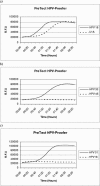Presence of E6 and E7 mRNA from human papillomavirus types 16, 18, 31, 33, and 45 in the majority of cervical carcinomas
- PMID: 16597856
- PMCID: PMC1448674
- DOI: 10.1128/JCM.44.4.1310-1317.2006
Presence of E6 and E7 mRNA from human papillomavirus types 16, 18, 31, 33, and 45 in the majority of cervical carcinomas
Abstract
The oncogenic potential of the human papillomavirus (HPV) early genes E6 and E7 is well established and a source of interest with regard to HPV testing for cervical carcinoma. Here we present a study performed with 204 histologically confirmed invasive cervical squamous cell carcinomas (SCCs) in which we evaluated the HPV E6 and E7 mRNA detection assay PreTect HPV-Proofer for detection of high-risk HPV types 16, 18, 31, 33, and 45. For further evaluation, detection of E6 and E7 mRNA from HPV types 35, 52, and 58 by real-time multiplex nucleic acid sequence-based amplification was also included. For comparison and to assess the overall prevalence of various HPV types, samples were also tested for HPV DNA by both consensus and type-specific PCR, reverse line blotting, sequencing, and in situ hybridization. The overall prevalence of HPV was 97%. HPV E6 and E7 transcripts were detected in 188 of 204 (92%) biopsy specimens, of which 181 contained one of the following HPV types: 16, 18, 31, 33, or 45. Consensus PCR and type-specific PCR detected HPV in 187 of 204 and 188 of 204 (92%) specimens, respectively. In conclusion, this study verifies the presence of HPV E6 and E7 mRNA in SCCs and demonstrates that HPV infections among Norwegian women with SCCs are limited mainly to the five high-risk types, 16, 18, 31, 33, and 45. This, together with the fact that PreTect HPV-Proofer detects the HPV oncogenic transcripts, suggests that the assay is a valuable approach in the field of HPV detection in cervical carcinoma.
Figures



Similar articles
-
Comparison of human papillomavirus messenger RNA and DNA detection: a cross-sectional study of 4,136 women >30 years of age with a 2-year follow-up of high-grade squamous intraepithelial lesion.Cancer Epidemiol Biomarkers Prev. 2005 Feb;14(2):367-72. doi: 10.1158/1055-9965.EPI-04-0410. Cancer Epidemiol Biomarkers Prev. 2005. PMID: 15734959
-
PreTect HPV-Proofer: real-time detection and typing of E6/E7 mRNA from carcinogenic human papillomaviruses.J Virol Methods. 2007 Jun;142(1-2):204-12. doi: 10.1016/j.jviromet.2007.01.036. Epub 2007 Mar 26. J Virol Methods. 2007. PMID: 17379322
-
Clinical performance of the PreTect HPV-Proofer E6/E7 mRNA assay in comparison with that of the Hybrid Capture 2 test for identification of women at risk of cervical cancer.J Clin Microbiol. 2010 Aug;48(8):2779-85. doi: 10.1128/JCM.00382-10. Epub 2010 Jun 23. J Clin Microbiol. 2010. PMID: 20573862 Free PMC article.
-
Triage of women with minor abnormal cervical cytology: meta-analysis of the accuracy of an assay targeting messenger ribonucleic acid of 5 high-risk human papillomavirus types.Cancer Cytopathol. 2013 Dec;121(12):675-87. doi: 10.1002/cncy.21325. Epub 2013 Jul 23. Cancer Cytopathol. 2013. PMID: 23881840 Review.
-
Human papilloma virus (HPV) and cervical cancer.J Med Invest. 2002 Aug;49(3-4):124-33. J Med Invest. 2002. PMID: 12323001 Review.
Cited by
-
Construction and identification of a yeast two-hybrid bait vector and its effect on the growth of yeast cells and the self-activating function of reporter genes for screening of HPV18 E6-interacting protein.J Huazhong Univ Sci Technolog Med Sci. 2010 Feb;30(1):8-12. doi: 10.1007/s11596-010-0102-8. Epub 2010 Feb 14. J Huazhong Univ Sci Technolog Med Sci. 2010. PMID: 20155448
-
Correlation between physical status of human papilloma virus and cervical carcinogenesis.J Huazhong Univ Sci Technolog Med Sci. 2012 Feb;32(1):97-102. doi: 10.1007/s11596-012-0017-7. Epub 2012 Jan 27. J Huazhong Univ Sci Technolog Med Sci. 2012. PMID: 22282253
-
Chromogenic in situ hybridization and p16/Ki67 dual staining on formalin-fixed paraffin-embedded cervical specimens: correlation with HPV-DNA test, E6/E7 mRNA test, and potential clinical applications.Biomed Res Int. 2013;2013:453606. doi: 10.1155/2013/453606. Epub 2013 Nov 24. Biomed Res Int. 2013. PMID: 24369532 Free PMC article.
-
Human papillomavirus prevalence and type distribution in urine samples from Norwegian women aged 17 and 21 years: A nationwide cross-sectional study of three non-vaccinated birth cohorts.Papillomavirus Res. 2016 Dec;2:153-158. doi: 10.1016/j.pvr.2016.05.002. Epub 2016 May 20. Papillomavirus Res. 2016. PMID: 29074174 Free PMC article.
-
Decoding impact of human papillomavirus in gynecological oncology: a narrative review.Obstet Gynecol Sci. 2025 Jan;68(1):30-42. doi: 10.5468/ogs.24226. Epub 2025 Jan 9. Obstet Gynecol Sci. 2025. PMID: 39780583 Free PMC article.
References
-
- Bosch, F. X., M. M. Manos, N. Munoz, M. Sherman, A. M. Jansen, J. Peto, M. H. Schiffman, V. Moreno, R. Kurman, K. V. Shah, et al. 1995. Prevalence of human papillomavirus in cervical cancer: a worldwide perspective. J. Natl. Cancer Inst. 87:796-802. - PubMed
Publication types
MeSH terms
Substances
LinkOut - more resources
Full Text Sources
Other Literature Sources
Medical

